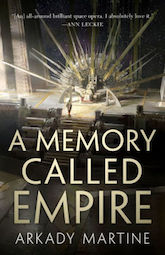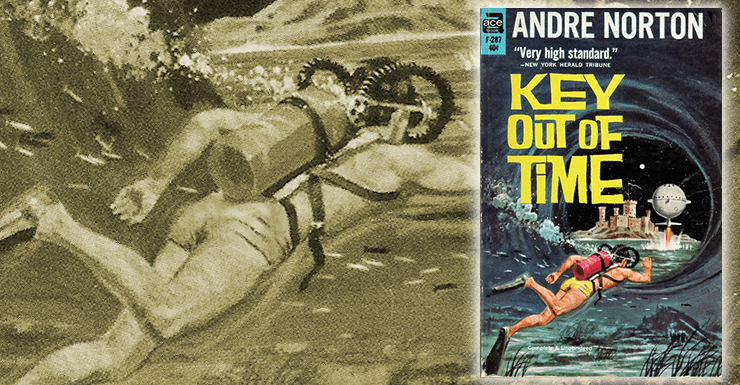I was apprehensive about Key Out of Time after the big huge NOPE of The Defiant Agents, but I’m happy to report that not only did Norton get back on track with this 1963 sequel, I really enjoyed it.
Ross Murdock and his mentor, Gordon Ashe, are back, along with a familiar set of villains. The debacle that led to the stranding of a group of Apaches on an alien world—we know what happened, but no one on Terra does—has led to some changes in the way the Time Agents operate, but they’re still sending ships out to worlds once colonized by the alien Baldies, still trying to stay ahead of the evil Reds, and still trying to populate them with members of “primitive” cultures.
At least this time they’re not brainwashing and regressing them, though with the sour taste of the previous volume still in my memory, I wondered as I read if that was because the Pacific Islanders of this expedition are already primitive enough not to need extra help.
But that thought was brief, and it seems from the story that they’re there voluntarily and they’re operating under their own brainpower—which is considerable. They’ve been sent to a Hawaiian-like planet that turns out to be nothing like the one the tape led them to expect, but not, at first, in a negative way. Not at all. It’s a dreamlike paradise of rose-colored skies and tropical archipelagoes, with geography totally different from that shown on the tape.
Ross and Ashe are part of the expedition, and are looking for some evidence of what happened to alter the world so completely. All they’ve found is an enigmatic set of broken pylons. As the novel opens, it’s nearly time to head back to Earth, and Ross and Ashe are getting rather desperate to find answers.
It’s not just academic curiosity, either. They’re afraid the Reds in present time will muck things up again as they’ve done so often before, and then there are the Baldies in the past, who are if anything even more of a threat.
Of course Ross finds an artifact just in the nick of time, but it’s still an enigma: some sort of metallic structure buried in the shallow sea bed. The only way to find out what happened is to set up a time scanner and do quick remote searches.
One of the islanders who’s joined in the venture is an ongoing irritant to Ross. She’s a girl. And she’s a telepath partnered with a pair of dolphins. Ross has next to no telepathic ability, and between that lack and his fundamental objection to females in male space, he is not happy.
The scanner finds the world shown on the tape, and homes in on a feudal castle occupied by humanoid aliens. But there are anomalies. Ships sailing toward the castle appear to be powered by engines, which doesn’t fit the rest of the technological level at all. And there’s the fact that, according to spot checks in later time periods, the culture was destroyed and the planet reshaped.
And now, the islanders say, there’s a bad storm coming in. A possible hurricane. Whatever Ashe and Ross want to do, they have to do it fast.
Ashe rigs a portable time portal. Just as the storm hits, he activates it—and Ross, who is observing, is sucked into it without warning. So, Ross presumes, is Ashe. And, he discovers somewhat later, the girl, Karara, and the dolphins.
At first Ross is all alone and nearly naked, and he finds himself in the middle of a wreckers’ trap. The people from the castle have lured a small fleet of ships onto the rocks and are looting the ships and killing the one survivor Ross happens to see. Ross is terrified that the dead man might be Ashe.
It turns out to be a native, to Ross’ relief, but he still has to find Ashe. Karara and the dolphins catch up with him, and they pool resources; then Ross catches one of the natives spying on the girl. It’s a boy from the wreckers’ castle, and he has a disability: a withered leg. (Which makes him one of Norton’s ongoing cast of disabled and differently-abled as well as diverse characters.)
The dolphins turn out to be able to read his mind, and Karara can read theirs. It’s cumbersome and pisses Ross off, but they’re able to communicate with him. They learn a great deal about the world and its people, and the boy swears fealty to Ross in the manner of his people. He’s an outcast from the castle, called “useless” because of his leg, but he manages more than well and proves invaluable to Ross and his fellow Terrans.
Eventually, with the help of a handy translating device, Ross learns enough of the language to communicate directly. By that time he’s been captured by the Rovers whose ships had been attacking the Wreckers’ castle, and has won their respect through a quick round of single combat with one of their strongest fighters. Karara they revere from the outset as a sort of goddess.
This is a classic Norton adventure, which means headlong action, breakneck pacing, and complicated plotting. Besides the piratical Rovers and the land-based Wreckers, there’s a third and much more mysterious force on this world, a group of magical or divine creatures called the Foanna. Ashe has been sold to them by the Wreckers, as “witches’ meat.”
Ross dreads the import of that, but he maintains a fair degree of hope. Ashe is a trained negotiator and a crack agent. If anyone can get himself out of slavery and cement an alliance with the Foanna, Ashe can.
Getting into the Foanna’s stronghold involves a great deal of sea voyaging and a huge complication. The Baldies are here, have given some of their technology to one of its lords, and are dividing the different peoples of this world in order to conquer. They’re behind the Rover-Wreckers war, and they’re framing the Foanna for it.
Ross turns out to be immune to the Foanna’s mental powers, which lets him get into their fortress, though none of his allies including Karara can follow. He finds Ashe there as expected, on excellent terms with the three weird and incalculably ancient sisters. Ultimately they all get together to lure the Baldies in and destroy them, but the cost to the Foanna is almost fatally high.
The plan achieves one of its goals: discovering the location of the Baldies’ ship. Ross again goes in solo, using his knowledge of another, identical ship, and sabotages their navigation tapes while the Foanna and Ashe and the Rovers take out the remaining Baldies. Once the aliens are launched off this world, they’ll end up somewhere very far away from their own civilization.
Which is kind of a self-sabotage as well, because Ashe and the Foanna had intended the Baldies to take a warning home and never venture near this planet again. Wherever they end up, they’ll probably not be able to warn anyone. They’ll be marooned.
Not that it really matters, as long as they leave this world alone. The humans are stranded here—their time portal was destroyed when they arrived—and they have no idea if they changed history enough to save the world or its people. As with the Apaches on Topaz, the agents are stuck. There’s no way back.
This novel is an everything bagel of Cool Stuff: time travel, plucky characters, interesting alien natives, evil alien invaders, spaceships, time portals, translation devices, telepathic people and animals, awesome animal companions, technology indistinguishable from magic, and of course ancient ruins—and better yet, real live ancient aliens. There’s also been a sort of sea change in how Norton structured her worlds and characters. Suddenly, the whole universe isn’t male. There are actual functional women characters, as well as alien females of great power and intellect.
This was happening to her work in general around about this time. Witch World also came out in 1963. We first met the reptilian alien “witches” of Warlock in 1960 in Storm Over Warlock. Now with these new witches—both the Foanna and the Witches of Estcarp—we’re seeing human or humanoid females who, literally, rule.
Buy the Book


A Memory Called Empire
What’s wickedly fun is that in Key Out of Time, our Plucky Norton Loner Guy finds himself face to face with the new world order, and he does not like it one bit. Ross Murdock is going through some stuff, and he’s being a complete asshole. He’s constantly stamping his feet and shaking his fists about how he’s a trained agent, and he’s in charge, and he isn’t going to be cut out of anything, thankyouverymuch. Ironically and karmically, when he shoves off on his own, either he doesn’t get the job done quite as he planned, or he messes it up in some way, or the only way to bring it home is to do it as part of the team.
His first reaction to Karara is pure sexist outrage. She doesn’t bat an eyelid. She goes where she wants to go, easily holds up her end of the mission, and when she does let Ross order her around, it’s because he has that Time Agent training and he has a mental block which makes him impervious to the Foanna’s defenses.
Karara rocks. And she has dolphin companions. She’s a great character, especially for this period of Norton’s career.
She’s not alone, either. The native who moves a key chunk of the plot is a woman and a priestess. She’s survived a terrible massacre, and she’s right in there with the men, planning the counterattack.
And then there are the Foanna. They’re Forerunners, like Simsa with their ancient heritage and their silver hair, though they’re very white instead of very dark. They have enormous powers and they are very, very, very old. They are not omnipotent and their powers have limits, and that is a strong part of their appeal. They pay a high price for saving their world, and they pay it with great courage.
Poor Ross is outnumbered. He eventually stops being butthurt and learns to accept the fact that his comfortable all-male world isn’t there anymore. Not without regret and not without devoutly wishing otherwise, but he finally faces the inevitable. By the end he even kind of likes it.
I can’t help thinking that Norton knew very well what she did there. Science fiction wasn’t just for boys anymore. Not that it ever really was, but she comes right out and says so, and through Ross, tells the boys to suck it up and deal.
I’m good with that.
Next time I’ll be starting the Game of Stars and Comets series with the first novel in the chronology (though it was the third to be published), The X Factor. More alien worlds, animal companions, and another functional girl character. Sixties Norton really was opening up her universe to the other half of humanity.
Judith Tarr’s first novel, The Isle of Glass, appeared in 1985. Her most recent novel, Dragons in the Earth, a contemporary fantasy set in Arizona, was published by Book View Cafe. In between, she’s written historicals and historical fantasies and epic fantasies and space operas, some of which have been published as ebooks from Book View Café. She has won the Crawford Award, and been a finalist for the World Fantasy Award and the Locus Award. She lives in Arizona with an assortment of cats, a blue-eyed dog, and a herd of Lipizzan horses.










